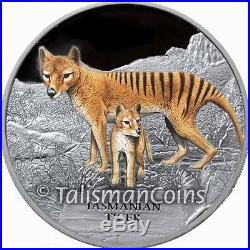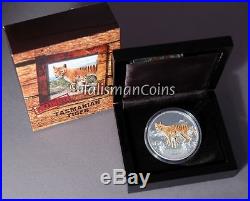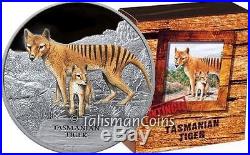Tuvalu 2011 Endangered + Extinct #1 Tasmanian Tiger $1 Pure Silver Proof Color




Preserve this extinct, carnivorous marsupial with this handsome, frosted cameo silver proof with color! It was a very sad day for our planet when, on September 7th, 1936, the last Tasmanian Tiger died of neglect at the Hobart Zoo. This large, striped, carnivorous marsupial was the apex predator in both Australian and Tasmania for untold generations; today, nothing remains of this truly remarkable creature except a few short, black and white movies, a few grainy photographs, and a few stuffed skins. In the name of wildlife preservation, we invite you to remember the 75th anniversary of the demise of an entire species with this pure. Portrait of an adult thylacine and its cub by wildlife artist Rod Scott. Tasmanian Wolf / Tasmanian Tiger. Greek for "dog-headed pouched one" was the largest known carnivorous marsupial of modern times.
It is commonly known as the Tasmanian Tiger (because of its striped back), the Tasmanian Wolf, and colloquially the Tassie tiger. Native to continental Australia, Tasmania and New Guinea, it became extinct in the 20th century.
It was the last extant member of its genus. The Tasmanian tiger resembled a large, short-haired dog with a stiff tail which smoothly extended from the body in a way similar to that of a kangaroo. Its yellow-brown coat featured 13 to 21 distinctive dark stripes across its back, rump and the base of its tail, which earned the animal the nickname "tiger". The thylacine was able to open its jaws to an unusual extent: up to 120 degrees. Its jaws were muscular and powerful, with 46 teeth.
Like the tigers and wolves of the Northern Hemisphere, from which it obtained two of its common names, the thylacine was an apex predator. As a marsupial, it was not closely related to these placental mammals, but because of convergent evolution it displayed the same general form and adaptations. Its closest living relative is thought to be either the Tasmanian Devil. The Tasmanian tiger had become extremely rare or extinct on the Australian mainland before European settlement of the continent, but it survived on the island state of Tasmania along with several other endemic species, including the Tasmanian devil.
Intensive hunting encouraged by bounties is generally blamed for its extinction, but other contributory factors may have been disease, the introduction of dogs, and human encroachment into its habitat. Despite its official classification as extinct, sightings are still reported, though none proven. The last known Tasmanian tiger lived in the Hobart Zoo, on Tasmania. Nicknamed "Benjamin", this thylacine died on 7 September 1936. It is believed to have died as the result of neglect.It was locked out of its sheltered sleeping quarters and exposed to a rare occurrence of extreme Tasmanian weather: extreme heat during the day and freezing temperatures at night. Ironically, official protection of the species by the Tasmanian government was introduced on 10 July 1936, 59 days before Benjamin died in captivity. Please see the presentation lower on this page for more information about Tuvalu and its association with Australia. The Tasmanian Tiger is the first release in the new Endangered & Extinct series. Like all the releases in the Deadly & Dangerous series.
Given the theme or topic of these coins as well as the woefully inadequate mintage limit of only 5,000 per release, it's only natural that collectors, investors and speculators have flocked to these beautiful coins and driven the prices skyward! The Perth Mint of Australia employs its own proprietary colorization technology, in which the color is actually sealed on the coin. The vibrant hues and precise execution of the technology create a stunning, full-color portrait on each coin. A full color, naturalistic portrait of an adult thylacine (Tasmanian Tiger) with its cub, in the remote wilderness of Tasmanian, by wildlife artist Rod Scott. The legend TASMANIAN TIGER defines the theme.Her Majesty, Queen Elizabeth II of England, in crowned profile facing right. This portrait, featuring Her Majesty wearing a tiara and pearl drop earrings, was executed by the sculptor Raphael Maklouf. The legend QUEEN ELIZABETH II, the date of issue and denomination also appear, while the legend 1 OZ 999 SILVER guarantees the weight and purity. The coin is encapsulated inside an elegant, luxury presentation case made of highly polished wood with black velvet and satin interior, and protected by a full-color outer box. An individually-numbered certificate of authenticity is included.
Rod Scott (obverse) Raphael Maklouf (reverse). The Island Nation of Tuvalu. Its nearest neighbors are Kiribati, Samoa and Fiji. It is comprised of four reef islands and five true atolls.
Its population of 11,992 makes it the third-least populated independent country in the world, with only Vatican City and Nauru having fewer inhabitants. It is also the second-smallest member by population of the United Nations. In terms of physical land size, at just 10 square miles Tuvalu is the fourth smallest country in the world, larger only than the Vatican City, Monaco and Nauru. The first inhabitants of Tuvalu were Polynesian people, who arrived about 3000 years go.
The islands came under Great Britain's sphere of influence in the late 19th century. The Ellice Islands were administered by Britain as part of a protectorate from 1892 to 1916 and as part of the Gilbert and Ellice Islands Colony from 1916 to 1974. In 1974 the Ellice Islanders voted for separate British dependency status as Tuvalu, separating from the Gilbert Islands which became Kiribati upon independence.
Tuvalu became fully independent within The Commonwealth in 1978. With Queen Elizabeth II as titular head of state. Because Tuvalu has few natural resources it has been dependent in recent years upon aid from larger, more developed nations, including Australia, New Zealand and the United States.
The Perth Mint of Australia is officially commissioned by the government of Tuvalu to produce legal tender coinage for the island nation. Talisman World Coins and Medals has been in business for more than 25 years and is one of the largest world coin direct distributors and wholesalers in the world. The item "Tuvalu 2011 Endangered + Extinct #1 Tasmanian Tiger $1 Pure Silver Proof Color" is in sale since Tuesday, October 30, 2012. This item is in the category "Coins & Paper Money\Coins\ World\Australia & Oceania\Australia\Commemorative". The seller is "talismancoins" and is located in Saint Louis, Missouri.
This item can be shipped worldwide.
- Circulated/Uncirculated: Uncirculated
- Year: 2011
- Composition: Silver
- Country of Manufacture: Australia
